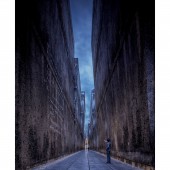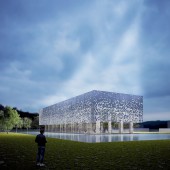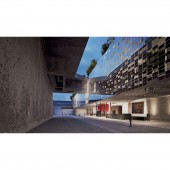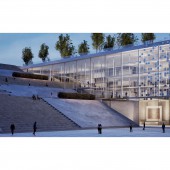
| THE AWARD |
| CATEGORIES |
| REGISTRATION |
| SUBMIT YOUR WORK |
| ENTRY INSTRUCTIONS |
| TERMS & CONDITIONS |
| PUBLICATIONS |
| DATES & FEES |
| METHODOLOGY |
| CONTACT |
| WINNERS |
| PRESS ROOM |
| GET INVOLVED |
| DESIGN PRIZE |
| DESIGN STORE |
| THE AWARD | JURY | CATEGORIES | REGISTRATION | PRESS | WINNERS | PUBLICATIONS | ENTRY INSTRUCTIONS |
The Afterlife Cultural Space by Michel Ghostine |
Home > Winners > Design #158388 >Interview |
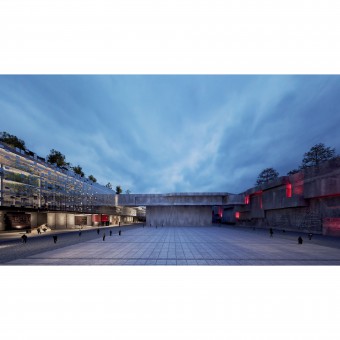 |
|
FS: What is the main principle, idea and inspiration behind your design?
MG: The main principle behind my design philosophy is to create spaces and structures that deeply resonate with human experience and emotion. Drawing inspiration from various art forms, including music, literature, and cinema, my designs aim to tell compelling stories and evoke powerful emotions. Whether it's a residential dwelling or a cultural landmark, each project is driven by a desire to enrich the lives of those who interact with it, fostering a sense of connection, belonging, and beauty in the built environment.
FS: What has been your main focus in designing this work? Especially what did you want to achieve?
MG: The main focus in designing this work is to transform a symbol of war and destruction into a beacon of hope and peace. The goal is to create a space that not only honors the memory of those affected by the Cold War but also inspires contemplation, understanding, and dialogue about peace. Through architectural interventions and symbolic gestures, the aim is to turn the bunker into a peace center that promotes reconciliation, education, and collective action towards a more peaceful world.
FS: What are your future plans for this award winning design?
MG: Implementing the award-winning design in Berlin is the primary future plan. The goal is to turn the conceptual vision into a tangible reality, creating a space that serves as a symbol of hope, remembrance, and peace for generations to come.
FS: How long did it take you to design this particular concept?
MG: 1 year.
FS: Why did you design this particular concept? Was this design commissioned or did you decide to pursuit an inspiration?
MG: The design of this concept stemmed from a deep sense of curiosity and intrigue upon learning about the bunker. Motivated by this, I reached out to the project lead in Berlin, visited the site, and embarked on a personal design journey to explore the potential of transforming the space into something meaningful and impactful.
FS: Is your design being produced or used by another company, or do you plan to sell or lease the production rights or do you intent to produce your work yourself?
MG: I intend to produce the work myself.
FS: What made you design this particular type of work?
MG: My fascination with the bunker and war relics sparked the vision to repurpose it into a cultural space, inviting the reimagining of the future for such sites.
FS: Where there any other designs and/or designers that helped the influence the design of your work?
MG: No
FS: Who is the target customer for his design?
MG: The world in general, the German government and the people in charge of the Honecker Bunker project.
FS: What sets this design apart from other similar or resembling concepts?
MG: The unique aspect of this design lies in its innovative approach to the facade, which reflects the bunker and symbolically shatters it into a million pieces, a concept I have yet to encounter elsewhere.
FS: How did you come up with the name for this design? What does it mean?
MG: "The Afterlife" suggests a transition from the past to the future, from conflict to harmony. It conveys the idea of rebirth and transformation, reflecting the project's aspiration to turn a once-militarized space into a symbol of renewal and hope
FS: Which design tools did you use when you were working on this project?
MG: Photoshop, Autocad, sketchup
FS: What is the most unique aspect of your design?
MG: The most unique aspect of the design is its facade, which serves as a transformative element. It reflects the bunker's imposing structure while simultaneously shattering it into a myriad of pieces. This dynamic facade symbolizes the transition from a symbol of war to a beacon of peace and cultural revitalization.
FS: Who did you collaborate with for this design? Did you work with people with technical / specialized skills?
MG: Collaborating with Mr. Hannes Hensel, the project lead at Honecker Bunker, was instrumental in bringing this design to fruition. His expertise and insights into the historical significance of the site enriched the project, ensuring that it honored the past while embracing a vision for the future.
FS: What is the role of technology in this particular design?
MG: We used technology to have enhanced visualization of the project to better depict the concept
FS: Is your design influenced by data or analytical research in any way? What kind of research did you conduct for making this design?
MG: Our design was heavily influenced by extensive research into the historical significance of the bunker and its impact on the surrounding area.
FS: What are some of the challenges you faced during the design/realization of your concept?
MG: One of the main challenges we faced during the design and realization of our concept was transforming a symbol of war into a space that promotes peace and reflection. Additionally, ensuring structural integrity while implementing architectural interventions posed technical challenges.
FS: How did you decide to submit your design to an international design competition?
MG: I received an invitation from A' Design about this project I had entered in another Competition. After researching A' Design I saw the value of submitting this project there.
FS: What did you learn or how did you improve yourself during the designing of this work?
MG: During the design process of this work, I learned the importance of perseverance, courage, and innovation. It taught me to overcome adversity and to approach design challenges with resilience and creativity.
FS: Any other things you would like to cover that have not been covered in these questions?
MG: No, all good.
FS: Thank you for providing us with this opportunity to interview you.
A' Design Award and Competitions grants rights to press members and bloggers to use parts of this interview. This interview is provided as it is; DesignPRWire and A' Design Award and Competitions cannot be held responsible for the answers given by participating designers.
| SOCIAL |
| + Add to Likes / Favorites | Send to My Email | Comment | View Press-Release |

